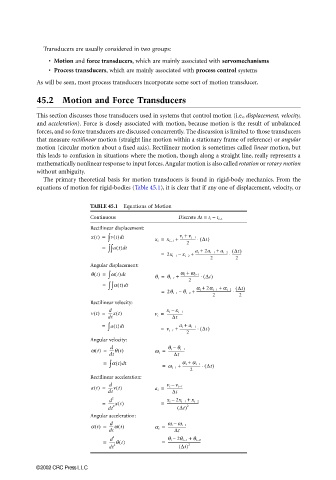Page 1163 - The Mechatronics Handbook
P. 1163
0066_frame_C45.fm Page 3 Thursday, January 10, 2002 4:58 PM
Transducers are usually considered in two groups:
• Motion and force transducers, which are mainly associated with servomechanisms
• Process transducers, which are mainly associated with process control systems
As will be seen, most process transducers incorporate some sort of motion transducer.
45.2 Motion and Force Transducers
This section discusses those transducers used in systems that control motion (i.e., displacement, velocity,
and acceleration). Force is closely associated with motion, because motion is the result of unbalanced
forces, and so force transducers are discussed concurrently. The discussion is limited to those transducers
that measure rectilinear motion (straight line motion within a stationary frame of reference) or angular
motion (circular motion about a fixed axis). Rectilinear motion is sometimes called linear motion, but
this leads to confusion in situations where the motion, though along a straight line, really represents a
mathematically nonlinear response to input forces. Angular motion is also called rotation or rotary motion
without ambiguity.
The primary theoretical basis for motion transducers is found in rigid-body mechanics. From the
equations of motion for rigid-bodies (Table 45.1), it is clear that if any one of displacement, velocity, or
TABLE 45.1 Equations of Motion
Continuous Discrete ∆t = t i − t i−1
Rectilinear displacement:
xt() = ∫ vt() t x i = x i−1 + v i + v i−1 ∆t)
d
------------------ (⋅
2
= ∫ ∫ at() t a i + 2a i−1 + a i−2 ( ∆t)
d
= 2x i−1 – x i−2 + ------------------------------------ ----------
⋅
2 2
Angular displacement:
q t() = ∫ w t() t q i = q i−1 + w i + w i−1 ∆t)
d
--------------------- (⋅
2
= ∫ ∫ a t() t a i + 2a i−1 + a i−2 ( ∆t)
d
= 2q i−1 – q i−2 + --------------------------------------- ----------
⋅
2 2
Rectilinear velocity:
d
vt() = -----xt() v i = x i – x i−1
------------------
dt ∆t
= ∫ at() t = v i−1 + a i + a i−1 ∆t)
d
------------------ (⋅
2
Angular velocity:
d
w t() = -----q t() w i = q i – q i−1
------------------
dt ∆t
= ∫ a t() t = w i−1 + a i + a i−1 ∆t)
d
-------------------- (⋅
2
Rectilinear acceleration:
d
at() = -----vt() a i = v i – v i−1
-----------------
dt ∆t
2
d
= -------xt() = x i – 2x i−1 + x i−2
------------------------------------
dt 2 ( ∆t) 2
Angular acceleration:
d
a t() = -----w t() a i = w i – w i−1
--------------------
dt ∆t
2
d
= -------q t() = q i – 2q i−1 + q i−2
-------------------------------------
dt 2 ( ∆t) 2
©2002 CRC Press LLC

